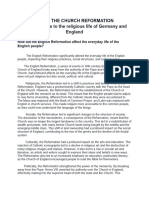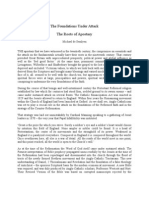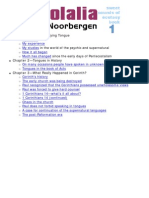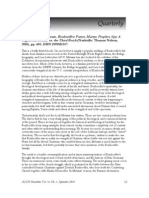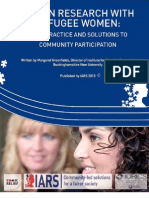0 ratings0% found this document useful (0 votes)
19 views7 The Impact of Reform: Par Excellence The Teleological View of History, and Bristle With
7 The Impact of Reform: Par Excellence The Teleological View of History, and Bristle With
Uploaded by
Jonel NaquitaThe document discusses the impact of the Protestant Reformation on religion, society, and the state. It had major effects like changing church ceremonies and customs, and reshaping religious worship. However, the impacts varied widely in different Protestant communities, and some areas retained many Catholic practices for decades.
Copyright:
© All Rights Reserved
Available Formats
Download as PDF, TXT or read online from Scribd
7 The Impact of Reform: Par Excellence The Teleological View of History, and Bristle With
7 The Impact of Reform: Par Excellence The Teleological View of History, and Bristle With
Uploaded by
Jonel Naquita0 ratings0% found this document useful (0 votes)
19 views2 pagesThe document discusses the impact of the Protestant Reformation on religion, society, and the state. It had major effects like changing church ceremonies and customs, and reshaping religious worship. However, the impacts varied widely in different Protestant communities, and some areas retained many Catholic practices for decades.
Original Description:
dfdfd
Original Title
978-0-230-21253-4_7
Copyright
© © All Rights Reserved
Available Formats
PDF, TXT or read online from Scribd
Share this document
Did you find this document useful?
Is this content inappropriate?
The document discusses the impact of the Protestant Reformation on religion, society, and the state. It had major effects like changing church ceremonies and customs, and reshaping religious worship. However, the impacts varied widely in different Protestant communities, and some areas retained many Catholic practices for decades.
Copyright:
© All Rights Reserved
Available Formats
Download as PDF, TXT or read online from Scribd
Download as pdf or txt
0 ratings0% found this document useful (0 votes)
19 views2 pages7 The Impact of Reform: Par Excellence The Teleological View of History, and Bristle With
7 The Impact of Reform: Par Excellence The Teleological View of History, and Bristle With
Uploaded by
Jonel NaquitaThe document discusses the impact of the Protestant Reformation on religion, society, and the state. It had major effects like changing church ceremonies and customs, and reshaping religious worship. However, the impacts varied widely in different Protestant communities, and some areas retained many Catholic practices for decades.
Copyright:
© All Rights Reserved
Available Formats
Download as PDF, TXT or read online from Scribd
Download as pdf or txt
You are on page 1of 2
7 The Impact of Reform
Historians have often made very sweeping claims about the
impact of the Reformation on religion, society and the state.
These range from practical matters such as the reshaping
of marriage laws, or the emergence of new forms of poor
relief, to broad political developments such as the growth
of the absolutist state, and vast generalisations about the
emergence of capitalism or the development of ‘secularisa-
tion’ or ‘modernisation’. Some of these latter claims display
par excellence the teleological view of history, and bristle with
so many question-begging prejudgments that they cannot be
adequately discussed in so brief a space as is available here.
It does seem certain, however, that recent research is leading
us to such a different understanding of the Reformation,
that many of these common notions about its impact should
be drastically revised.
The most obvious area of impact was in the conduct and
organisation of church life. Many traditional religious
ceremonies and customs were abolished, as well as many tra-
ditional feast days. The most important, because of the
impressive religious and secular ceremony with which it had
been observed, was the feast of Corpus Christi, celebrating
the Real Presence of Christ in the consecrated bread and
wine. Religious worship was radically reshaped: the Mass
became the celebration of the Lord’s Supper, conducted in
the vernacular by a minister in a plain black gown who faced
the congregation over a table, using bread instead of a wafer,
and who offered the cup to the laity. The sermon became
more central to religious worship, and in some places a
daily sermon replaced daily Mass, while the Lord’s Supper
was received infrequently, often no more than monthly, and
sometimes only at Christmas and Easter. The only other
55
R. W. Scribner and C. S. Dixon, The German Reformation
© R. W. Scribner 2003
Sacrament recognised was Baptism, although Penance
continued as a pious practice in some places. Marriage went
through a curious change, for although it was no longer
recognised as a Sacrament, the ceremony was made more
religious than in the past, with a service in church being
given greater prominence over secular celebrations (116).
These were significant changes, especially in the most
radically reformed places, but there was wide variation in
many Protestant communities. In some places the liturgy
could appear much the same as it had under the old religion,
and often the service book being used well into the later part
of the sixteenth century was merely a German translation of
the old Latin Mass Book. In parts of Saxony vestments and
candles were used for the Lord’s Supper, and until the mid-
dle of the century even the practice of the Elevation, holding
aloft the consecrated bread for the adoration of the congre-
gation. Many images were retained in Lutheran churches,
while church buildings themselves saw only minimal alter-
ation to adapt them to the new form of worship. It was not
until 1618 that the first uniquely Protestant ‘preaching
church’ was built, in Nidda in Hessen, resembling a meeting
house more than a traditional church (133). In Brandenburg
the liturgy retained much of its Catholic outward appear-
ance, although it had turned Protestant in 1540. This was
largely because of the affection of the Elector Joachim II for
the colour and display of Catholic ritual, and many Catholic
practices remained for the next sixty years (33).
The most marked changes were seen in the new clergy.
They lost many of their old legal and financial privileges,
removing one of the greatest causes of anticlericalism. Here,
however, the reformers had merely supplied a theological
justification for a trend already present during the fifteenth
century, of subjecting the clergy to secular duties and
responsibilities. More striking was the emergence of a mar-
ried clergy, which brought them closer to married parish-
ioners, and stabilised the lives of those unable to face the
demands of celibacy (113). It also relieved lay fears about the
sexual predatoriness of the old clergy: better to have married
priests than have them chasing one’s wife or daughters.
Even so, the change was not as radical as has been claimed.
56
You might also like
- Walter Kasper-That They May All Be One - The Call To Unity Today-Burns & Oates (2005) PDFDocument209 pagesWalter Kasper-That They May All Be One - The Call To Unity Today-Burns & Oates (2005) PDFcezargradinaru100% (1)
- The 100 Most Important Events in Christian HistoryFrom EverandThe 100 Most Important Events in Christian HistoryRating: 5 out of 5 stars5/5 (1)
- Deconstructing Sacramental Theology and Reconstructing Catholic RitualFrom EverandDeconstructing Sacramental Theology and Reconstructing Catholic RitualNo ratings yet
- Davies - The Catholic Sanctuary and Vatican IIDocument18 pagesDavies - The Catholic Sanctuary and Vatican IIhobojoe9127No ratings yet
- The Banished Heart. Origins of Heteropraxis in The Catholic ChurchDocument9 pagesThe Banished Heart. Origins of Heteropraxis in The Catholic ChurchQuo PrimumNo ratings yet
- Case Study Ethical Paper:: Bs Crim 1-BDocument7 pagesCase Study Ethical Paper:: Bs Crim 1-BJonel Naquita100% (1)
- Were Changes in Catholic Theology, Organization and Religious Life Largely A Response To The Protestant Reformation?Document5 pagesWere Changes in Catholic Theology, Organization and Religious Life Largely A Response To The Protestant Reformation?Shadow BoomNo ratings yet
- The Liturgical Movement and Reformed WorshipDocument9 pagesThe Liturgical Movement and Reformed Worshiptulsukleo2268No ratings yet
- Nadams,+19800611 35 264-286Document23 pagesNadams,+19800611 35 264-286RajanNo ratings yet
- De Propaganda Fide, Which Revealed A Very Traditional Posture. To This, The African and AsianDocument5 pagesDe Propaganda Fide, Which Revealed A Very Traditional Posture. To This, The African and AsianEverything new100% (1)
- Church History Ni ChachaDocument5 pagesChurch History Ni ChachaCha ChaNo ratings yet
- Lesson 5 The Sacramental Life of Early Christian CommunitieDocument15 pagesLesson 5 The Sacramental Life of Early Christian CommunitieHaydee FelicenNo ratings yet
- Short Paper - Didache by Ohahimere David IbhaluobeDocument7 pagesShort Paper - Didache by Ohahimere David IbhaluobeDavid IbhaluobeNo ratings yet
- Lut 31 1 DieterDocument28 pagesLut 31 1 DieterYosueNo ratings yet
- Research On Vatican II: Ust Angelicum CollegeDocument8 pagesResearch On Vatican II: Ust Angelicum CollegeDrei PeraltaNo ratings yet
- Liturgy As Proclamation of The Word: by S. M. GibbardDocument15 pagesLiturgy As Proclamation of The Word: by S. M. GibbardFederico Galeano RománNo ratings yet
- The Reform of The Roman Rite by Msgr. Andrew WadsworthDocument8 pagesThe Reform of The Roman Rite by Msgr. Andrew WadsworthNew Liturgical MovementNo ratings yet
- The Externals of The Catholic ChurchDocument428 pagesThe Externals of The Catholic ChurchLibardo Sánchez100% (1)
- 2007 Studies of Religion NotesDocument4 pages2007 Studies of Religion NotesAryan Sheth-PatelNo ratings yet
- Anglicans, Eucharistic Sacrifice and Evangelical RitualDocument63 pagesAnglicans, Eucharistic Sacrifice and Evangelical RitualFabio Bighetti100% (3)
- British History 1500-1700 Revision NotesDocument81 pagesBritish History 1500-1700 Revision NotesJiayue ShiNo ratings yet
- The Jesuits and Counter ReformationDocument8 pagesThe Jesuits and Counter Reformationsimiyubrian777No ratings yet
- Although We Be Unworthy Anglicans EucharDocument53 pagesAlthough We Be Unworthy Anglicans Eucharphilipjudeacidre100% (1)
- RE ReformationDocument5 pagesRE ReformationMessie LacsonNo ratings yet
- ROUWHORST, Liturgical Movements in Culture and Society, JLO 22, 2006, P. 67-77Document12 pagesROUWHORST, Liturgical Movements in Culture and Society, JLO 22, 2006, P. 67-77eborsottiNo ratings yet
- (Catholic Christendom, 1300-1700) Helen Parish-Clerical Celibacy in The West - C.1100-1700-Ashgate (2010)Document295 pages(Catholic Christendom, 1300-1700) Helen Parish-Clerical Celibacy in The West - C.1100-1700-Ashgate (2010)OrsolyaHegyiNo ratings yet
- English Revolution HistoriographyDocument7 pagesEnglish Revolution HistoriographyayushNo ratings yet
- Research PaperDocument6 pagesResearch PaperSäng CulbenganNo ratings yet
- Timothy George The Reformation Roots of The Baptist TraditionDocument17 pagesTimothy George The Reformation Roots of The Baptist TraditionAdalid Garcia Rodriguez100% (1)
- Sacraments ReviewerDocument9 pagesSacraments ReviewerIan mar LimbagNo ratings yet
- British SecularisationDocument4 pagesBritish SecularisationGabriel LambertNo ratings yet
- How Has The Eucharistic Celebration Changed Over TimeDocument5 pagesHow Has The Eucharistic Celebration Changed Over TimeAnonymous YHPAgRRDNo ratings yet
- The Ottaviani InterventionDocument15 pagesThe Ottaviani InterventionACCobraGNo ratings yet
- Anello PriestlyCelibacyIdentity 2014Document28 pagesAnello PriestlyCelibacyIdentity 2014Juan Miguel Dela MercedNo ratings yet
- Sancta Missa: RitesDocument34 pagesSancta Missa: RitesWilson da SilvaNo ratings yet
- Whatever Happened To The ReformationDocument6 pagesWhatever Happened To The ReformationDavid SalazarNo ratings yet
- The Proto-History of The Roman Liturgical ReformDocument15 pagesThe Proto-History of The Roman Liturgical ReformTea LeafNo ratings yet
- Sacrosanctum Concilium Oct. 20Document5 pagesSacrosanctum Concilium Oct. 20Roger Ryan AlbaNo ratings yet
- The Possibility of Reconciling The Liturgical Calendars of The Extraordinary Form and The Ordinary Form, Fr. Angelo Van Der Putten, FSSPDocument4 pagesThe Possibility of Reconciling The Liturgical Calendars of The Extraordinary Form and The Ordinary Form, Fr. Angelo Van Der Putten, FSSPNew Liturgical MovementNo ratings yet
- Liturgical Year - ActivitiesDocument9 pagesLiturgical Year - Activitiessr.sowmiya thereseNo ratings yet
- Reform of the Reform?: A Liturgical DebateFrom EverandReform of the Reform?: A Liturgical DebateRating: 3.5 out of 5 stars3.5/5 (2)
- The Fiftieth Anniversary of The Official Avowal of Our Church's Episcopal Consecrations by The Russian Orthodox Church AbroadDocument19 pagesThe Fiftieth Anniversary of The Official Avowal of Our Church's Episcopal Consecrations by The Russian Orthodox Church AbroadHibernoSlavNo ratings yet
- Which Was A Larger Threat To The Elizabethan Church, Catholicism or PuritanismDocument5 pagesWhich Was A Larger Threat To The Elizabethan Church, Catholicism or PuritanismJames CollardNo ratings yet
- Early Modern EnglandDocument9 pagesEarly Modern EnglandDenise TomasNo ratings yet
- History of Christian Doctrine Vol 2Document336 pagesHistory of Christian Doctrine Vol 2Ada Link100% (1)
- World's ReligionDocument40 pagesWorld's ReligionAileen AddunNo ratings yet
- 1987 Letter Monk Ephraim To PolychroniosDocument14 pages1987 Letter Monk Ephraim To PolychroniosHibernoSlavNo ratings yet
- Foundations Under AttackDocument12 pagesFoundations Under AttackJesus LivesNo ratings yet
- (New Century Theology Ser.) Keith Pecklers - Worship-Bloomsbury Publishing PLC (2003)Document241 pages(New Century Theology Ser.) Keith Pecklers - Worship-Bloomsbury Publishing PLC (2003)VerlaneNo ratings yet
- How Far Did The Pre Reformation Church Meet The Needs of The People?Document5 pagesHow Far Did The Pre Reformation Church Meet The Needs of The People?smike95No ratings yet
- Evolution of The SacramentsDocument4 pagesEvolution of The SacramentsFr Jesmond MicallefNo ratings yet
- David K. Bernard A History of Christian Doctrine Volume 2, The Reformation To The Holiness Movement A. D. 1500-1900 1995Document334 pagesDavid K. Bernard A History of Christian Doctrine Volume 2, The Reformation To The Holiness Movement A. D. 1500-1900 1995aasanasan100% (2)
- Short History of The Roman MassDocument18 pagesShort History of The Roman MassDouglas100% (2)
- 10 Years Without Michael DaviesDocument10 pages10 Years Without Michael DaviesFederico Ceriani100% (1)
- Pentecost 21: "500th Anniversary of The Reformation"Document3 pagesPentecost 21: "500th Anniversary of The Reformation"Tim GadenNo ratings yet
- Holy Tradition Vs Sola Scriptura The WitDocument21 pagesHoly Tradition Vs Sola Scriptura The Witkmt tubeNo ratings yet
- Week 8-Requirements Elicitation & AnalysisDocument7 pagesWeek 8-Requirements Elicitation & AnalysisJonel NaquitaNo ratings yet
- Batangas State University Jplpc-Malvar: Budget Summary Total Cost: - 000.00Document7 pagesBatangas State University Jplpc-Malvar: Budget Summary Total Cost: - 000.00Jonel NaquitaNo ratings yet
- 7 QueeniePearlV TomaroDyahMutiarin90-104Document26 pages7 QueeniePearlV TomaroDyahMutiarin90-104Jonel NaquitaNo ratings yet
- CS111 IM Week 3Document63 pagesCS111 IM Week 3Jonel NaquitaNo ratings yet
- BJMP Case AnalysisDocument25 pagesBJMP Case AnalysisJonel NaquitaNo ratings yet
- Psystat Lecture Asynchronous Task 3Document1 pagePsystat Lecture Asynchronous Task 3Jonel NaquitaNo ratings yet
- Was Was: (COOP Project), l,2Document12 pagesWas Was: (COOP Project), l,2Jonel NaquitaNo ratings yet
- Web-Based Billing and Collection System For A Municipal Water and Services UnitDocument30 pagesWeb-Based Billing and Collection System For A Municipal Water and Services UnitJonel NaquitaNo ratings yet
- Wondershare Filmora9 Review and Tutorial #1 - What's NewDocument5 pagesWondershare Filmora9 Review and Tutorial #1 - What's NewJonel NaquitaNo ratings yet
- Amelita Sari PDFDocument13 pagesAmelita Sari PDFJonel NaquitaNo ratings yet
- Wondershare Filmora9 Review and Tutorial #1 - What's NewDocument5 pagesWondershare Filmora9 Review and Tutorial #1 - What's NewJonel NaquitaNo ratings yet
- Introduction To Programming (In C++) : Data Types and VisibilityDocument24 pagesIntroduction To Programming (In C++) : Data Types and VisibilityJonel NaquitaNo ratings yet
- Andres Bonifacio and Other Leaders of The KatipunanDocument5 pagesAndres Bonifacio and Other Leaders of The KatipunanJonel NaquitaNo ratings yet
- Overview of The Current State of Technology in The PhilippinesDocument1 pageOverview of The Current State of Technology in The PhilippinesJonel NaquitaNo ratings yet
- Smart Goods Billing Management and Payment System: March 2018Document7 pagesSmart Goods Billing Management and Payment System: March 2018Jonel NaquitaNo ratings yet
- Semis Handout Graph TheoryDocument5 pagesSemis Handout Graph TheoryJonel NaquitaNo ratings yet
- Midterm Handout Sets and FunctionsDocument9 pagesMidterm Handout Sets and FunctionsJonel NaquitaNo ratings yet
- Gonzaga Gemath Bsp1aDocument1 pageGonzaga Gemath Bsp1aJonel NaquitaNo ratings yet
- Res101 Abayon-Valencia CommentedDocument38 pagesRes101 Abayon-Valencia CommentedJonel NaquitaNo ratings yet
- Magna Mundi PlatinumDocument176 pagesMagna Mundi PlatinumTrajano1234No ratings yet
- Christian MissionsDocument540 pagesChristian Missionshisjf100% (2)
- US News Rankings Liberal Arts Colleges Through 2021Document71 pagesUS News Rankings Liberal Arts Colleges Through 2021Michael LanNo ratings yet
- Apush Chapter 1 OutlineDocument10 pagesApush Chapter 1 OutlineGibran LeNo ratings yet
- GlossolaliaDocument87 pagesGlossolalianoimmy183983% (6)
- Dominic Emmanuel SVD (Auth.) - Challenges of Christian Communication and Broadcasting - Monologue or Dialogue - (1999, Palgrave Macmillan UK)Document206 pagesDominic Emmanuel SVD (Auth.) - Challenges of Christian Communication and Broadcasting - Monologue or Dialogue - (1999, Palgrave Macmillan UK)gabby macaNo ratings yet
- Indfoedsretsproeven ENDocument216 pagesIndfoedsretsproeven ENMadan JoshiNo ratings yet
- The History of Education Educational Practice and Progress Considered As A Phase of The Development and Spread of Western Civilization by Cubberley, Ellwood PattersonDocument619 pagesThe History of Education Educational Practice and Progress Considered As A Phase of The Development and Spread of Western Civilization by Cubberley, Ellwood PattersonGutenberg.orgNo ratings yet
- ELEMENT OF CONTRACT IN Dr. FAUSTUSDocument18 pagesELEMENT OF CONTRACT IN Dr. FAUSTUSdikshaNo ratings yet
- Synfocity : Synod Executive Committee Vawi 280-NaDocument3 pagesSynfocity : Synod Executive Committee Vawi 280-NaMizoram Presbyterian Church SynodNo ratings yet
- Apr-Jun 2015 Schrock Prayer LetterDocument1 pageApr-Jun 2015 Schrock Prayer LetterojschrockNo ratings yet
- DBQDocument3 pagesDBQJordan Niyogi0% (1)
- Letter For The Church LeadershipDocument2 pagesLetter For The Church LeadershipJunel King VillarNo ratings yet
- The British CharacterDocument3 pagesThe British CharacterDiamondNo ratings yet
- Lebanon Road Church of ChristDocument2 pagesLebanon Road Church of ChristklesuerNo ratings yet
- The - Glorious - Reformation - S. S. SCHMUCKERDocument41 pagesThe - Glorious - Reformation - S. S. SCHMUCKERstarinicioms100% (1)
- Powers and Procedures of BaptismDocument19 pagesPowers and Procedures of BaptismIfechukwu U. IbemeNo ratings yet
- Jenny - Stevens - Faith Fiction and The Historical JesusDocument32 pagesJenny - Stevens - Faith Fiction and The Historical JesusΚΩΝΣΤΑΝΤΙΝΟΣ ΓΙΑΝΝΑΚΗΣNo ratings yet
- 1899Document143 pages1899WatchtowerdestructionNo ratings yet
- Bonhoeffer: Pastor, Martyr, Prophet, Spy: A Righteous Gentile vs. The Third ReichDocument3 pagesBonhoeffer: Pastor, Martyr, Prophet, Spy: A Righteous Gentile vs. The Third ReichJon TrottNo ratings yet
- International Development From An Integrative PerspectiveDocument173 pagesInternational Development From An Integrative PerspectiveWilliam Carey International University PressNo ratings yet
- Culture in Action Symbols and Strategies by SwidllerDocument15 pagesCulture in Action Symbols and Strategies by SwidllerRikka EspedillaNo ratings yet
- Efn 102 History of EducationDocument161 pagesEfn 102 History of EducationEVERLYNE JEMUTAINo ratings yet
- Kosin Presbyterian Church in KoreaDocument4 pagesKosin Presbyterian Church in Koreamaxwell498No ratings yet
- Action Research With Refugee Women: Good Practice and Solutions To Community ParticipationDocument25 pagesAction Research With Refugee Women: Good Practice and Solutions To Community ParticipationIARS_PublicationsNo ratings yet
- A History of Philosophic Ideas About SportDocument21 pagesA History of Philosophic Ideas About SportEmmanuel Estrada AvilaNo ratings yet
- Witch Trials Peter T. Leeson and Jacob W. RusDocument40 pagesWitch Trials Peter T. Leeson and Jacob W. RusNaNo ratings yet
- DownloadarticleDocument20 pagesDownloadarticleRoxane DumayasNo ratings yet
- How Many Marks?: Three Reformation ViewsDocument2 pagesHow Many Marks?: Three Reformation ViewsobahamondetNo ratings yet
- KnightsDocument18 pagesKnightsapi-3697060No ratings yet










